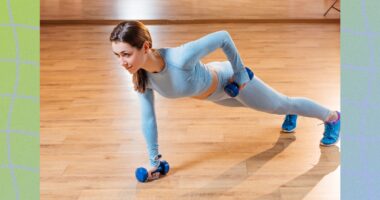
For example, you can try progressive muscle relaxation (which you can even do in bed!). This simply involves tensing your muscles and relaxing them one body part at a time, SELF previously reported. First, try scrunching and tensing your toes tightly for about 5 to 10 seconds. Then, release them and feel the difference in the sensations. Slowly move up your body, muscle by muscle, to your calves, thighs, and so on. (Find a full list of grounding techniques for anxiety here).
9. Do some gentle bedtime yoga or stretching.
Yes, vigorous exercise before bed might keep you up, but consider grabbing your yoga mat and doing some gentle exercises to help you relax before bed. Why? Static stretching encourages deep breathing, which encourages your relaxation response, SELF previously reported. Looking for a few ideas? We have a 5-minute bedtime stretching routine you can try tonight.
10. Avoid dozing off during a TV show.
Remember, as the sun goes down, your pineal gland begins to pump melatonin into your bloodstream. When you keep any lights on, even if it’s just a seemingly small bit of light emitted from your iPad screen while streaming your favorite TV show, it can interfere with this melatonin signaling and make it a little more challenging to fall asleep fast, SELF previously reported. And even if you do feel knocked out, there’s also some evidence that the variances in TV light throughout the night can keep you from getting quality sleep.
11. Put an end to your “doom scrolling” habit.
We’ve already discussed how light from your phone can interfere with melatonin production, but we haven’t addressed how scrolling through your phone, reading new coronavirus updates, checking email, or chatting with your friend in Hong Kong can keep your mind active.
Dr. Malow suggests turning off your phone and other devices a full hour before bed to help you wind down. You can also set your phone to go into sleep mode or get a screen for your computer that blocks blue light, she says. Some people also find it helpful to wear blue light-blocking glasses in the evening to reduce eye strain, too.
If you find that racing thoughts or mindless phone use is to blame, consider switching it out for a good book before bed.
12. Eliminate other light, too.
While you’re at, get rid of all light sources where you can. “If we have too much light at the wrong time, it can tell your body to wake up and stay awake,” Dr. Augelli explains. “So we have to be careful about the timing of our light consumption.”
READ RELATED: Obituary- Who is Fresh Ego Kid Marvin Morgan? Death Cause and Net worth
Perhaps you can get curtains that block street light or get a door stopper to prevent light from coming in through the gap. If you can’t control the amount of light in your room, think about getting an eye mask to help ensure it’s as dark as possible in your sleeping environment.
13. Consider the sound quality in your room.
Much like light can keep you awake, sounds—like from your TV or your loud neighbors—can keep you up longer than you’d like. If ambient sounds are an issue, try to use a fan or white noise machine to help alleviate that. The consistent whir of a sound machine can help soften the impact of other erratic noise that could keep you awake, the CDC suggests. If that doesn’t help, earplugs are another option to consider.
14. Regulate the temperature in your room.
Light gets a lot of credit for encouraging your circadian rhythm to do its job, but temperature also plays a role. As SELF previously reported, a room that’s between 60 and 67 degrees Fahrenheit tends to be most people’s sleepy-time sweet spot. If you can’t regulate the temperature in your room, consider switching up your bedding or sleeping in lighter (or heavier) pajamas to get your ideal sleep temperature.
15. Stop watching the clock.
Even if you’re having trouble sleeping, quit checking the time. This will make you feel more anxious (and awake, if you’re using your phone), which only makes it harder to fall back asleep. If you find yourself doing this often, try turning the clock away from you or keeping it out of reach so you’re not tempted to watch the time pass, the Cleveland Clinic suggests.
16. Do something calming if you find yourself tossing and turning.
If you’re tired but can’t sleep, it’s natural to move around in bed to bide your time. But this isn’t very productive. More often than not, tossing and turning leads to frustration that works against falling asleep faster. Instead of huffing and puffing, try getting out of bed and leaving your bedroom for about 20 minutes to do something relaxing, the Mayo Clinic suggests. Read, listen to soothing music, or engage in another calming habit until you’re feeling more tired, then climb back into bed and give it another try.
Do I need to see a doctor to figure out why I can’t sleep at night?
There are so many reasons why you might have trouble falling asleep fast (and staying asleep once do nod off). But there’s a difference between tossing and turning due to lifestyle factors you can change and feeling tired or not sleeping because of a sleep disorder, like insomnia, narcolepsy, or sleep apnea.
Source: SELF









